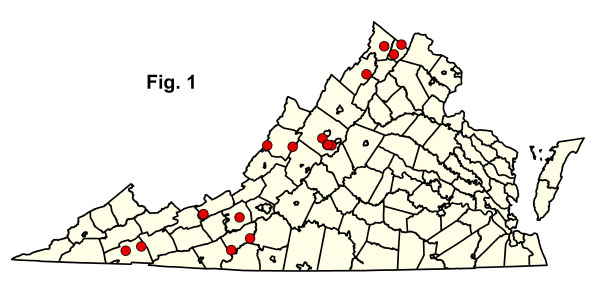
 保育與休閒部
保育與休閒部 保育。保護。享受。
 保育與休閒部
保育與休閒部  目錄
目錄石灰岩和泉沼澤
這個群組包括岩石的山坡或腳坡的泉水滲漏;河流或河流平原露台上的草原類濕地和草地,不斷被鄰近的地下水或鄰近斜坡滲透的沼澤植物;以及在同一景觀中季節性被地下水浸入的沼澤般植物。這些小塊濕地在弗吉尼亞州僅限於嶺和瓦利省碳酸岩區的幾個地點。
The vegetation of hillside/foot-slope fens is often a patch-mosaic of shrubs and herbaceous openings. Habitats typically have irregular or hummock-and-hollow microtopography, with areas of muck and abundant gravel or travertine marl deposits in the seepage rills. Soils, which are typically derived from underlying limestone or dolostone, are slightly to moderately alkaline with high calcium levels. Strictly defined, fens are minerotrophic wetlands with organic soils > 40 cm deep. Because they usually have only superficial organic soil layers, most of the Virginia communities in this group are technically "seeps," although we retain the term "fen" due to its wide application to various base-rich seepage wetlands in the southeastern United States; see Weakley and Schafale (1994) for additional discussion. Common shrubs include willows (Salix spp.), smooth alder (Alnus serrulata), swamp rose (Rosa palustris), alder-leaved buckthorn (Rhamnus alnifolia), and chokeberries (Aronia arbutifolia and Aronia prunifolia). Herbaceous species that are more or less diagnostic of calcareous fens or seeps include several sedges (e.g ., Carex flava, Carex hystericina, Carex interior, Carex schweinitzii, Carex suberecta, Carex tetanica), showy lady's-slipper (Cypripedium reginae), small-headed rush (Juncus brachycephalus), bog twayblade (Liparis loeselii), large-leaved grass-of-parnassus (Parnassia grandifolia), swamp lousewort (Pedicularis lanceolata), shining ladies'-tresses (Spiranthes lucida), and needle beaksedge (Rhynchospora capillacea). Other common herbs include bristly-stalk sedge (Carex leptalea var. leptalea), royal fern (Osmunda spectabilis), and golden ragwort (Packera aurea).
Vegetation of prairie fens is diverse and generally graminoid-dominated; patch-dominance of sedges (e.g., Carex stricta, Carex tetanica, Carex interior, Carex buxbaumii, Carex prairea, Carex suberecta, Carex trichocarpa), baltic rush (Juncus balticus var. littoralis), bald spikerush (Eleocharis erythropoda), common threesquare (Schoenoplectus pungens var. pungens), freshwater cordgrass (Spartina pectinata), switchgrass (Panicum virgatum var. virgatum) and, at a single known Virginia site, holy grass (Hierochloe hirta) is typical. Many low-cover forbs are also components, including several state-rare and unusual species, such as queen-of-the-prairie (Filipendula rubra), prairie loosestrife (Steironema quadriflorum), spotted joe-pye weed (Eutrochium maculatum var. maculatum), northern winged loosestrife (Lythrum alatum), hooded skullcap (Scutellaria galericulata), rough avens (Geum laciniatum), purple fringeless orchid (Platanthera peramoena), and marsh pea (Lathyrus palustris). Reed canary grass (Phalaris arundinacea) is a native perennial grass that frequently becomes invasive in disturbed wet prairies.

Calcareous Spring Marshes, sometimes referred to as "muck fens," occupy groundwater-flooded sloughs, abandoned meanders, depressions, and spring overflows on large stream or river floodplain terraces. Restricted to a few sites in carbonate rock districts of the Ridge and Valley region, these very rare habitats are highly threatened by impoundments and ditching, grazing, and agricultural pollution. Deep, hydric muck soils have high calcium levels and are more or less permanently saturated or flooded by perched groundwater or seepage inputs. Vegetation is marsh-like and characterized by coarse emergent species: arrow-arum (Peltandra virginica), bur-reeds (Sparganium eurycarpum and Sparganium americanum), water smartweed (Persicaria amphibia), lake-bank sedge (Carex lacustris), hop sedge (Carex lupulina), Virginia cutgrass (Leersia virginica), smooth bur-marigold (Bidens laevis), sweetflag (Acorus calamus), marsh-marigold (Caltha palustris var. palustris), skunk-cabbage (Symplocarpus foetidus), spotted jewelweed (Impatiens capensis), blueflag iris (Iris versicolor), and broad-leaved cattail (Typha latifolia). Buckbean (Menyanthes trifoliata) and water horsetail (Equisetum fluviatile), both very rare species in Virginia, are components at two sites each. A most unusual site in Clarke County consists of a 2 ha (5 ac) marsh developed in the overflow of powerful artesian springs. The marsh here is dominated by broad-leaved cattail and the state-rare, northern disjunct beaked sedge (Carex utriculata), while deep channels support the similarly disjunct flatstem pondweed (Potamogeton zosteriformis).
Tall grasslands occurring on moderately well drained to somewhat poorly drained floodplain terraces in mountain valleys of the Ridge and Valley region are included in this group due to their close association on the landscape with the fens. These communities, which are comparable to "tall-grass prairies" of midwestern states, are known from only a few sites in western Virginia. Their original, pre-colonial extent and the ecological dynamics which maintained them (e.g ., fire, grazing) are now conjectural. Some of the present-day occurrences may be artifacts of post-settlement clearing and grazing. Although these communities are included in the Palustrine system, some examples may not be wetlands in the strict sense. The hydrology of our few examples appears to vary from rather well-drained to seasonally saturated or even briefly flooded. Surficial soils vary from sandy-gravelly to mottled loamy-clayey, and from slightly acidic to moderately alkaline. The vegetation is dominated by the tall, warm-season grasses big bluestem (Andropogon gerardii) and indian grass (Sorghastrum nutans). Associated species with prairie affinities include willow aster (Symphyotrichum praealtum var. angustior), = Aster praealtus var. angustior), rigid sedge (Carex tetanica), eastern indian paintbrush (Castilleja coccinea), northern rattlesnake-master (Eryngium yuccifolium var. yuccifolium), dense blazing star (Liatris spicata var. spicata), Virginia mountain-mint (Pycnanthemum virginianum), and Culver's-root (Veronicastrum virginicum). Conversion to agricultural fields, cattle grazing, invasive introduced weeds, woody succession, and perhaps fire exclusion represent serious threats to these small, remnant prairies.
使所有這些社區保持開放的生態因素尚未充分了解,許多例子似乎受到灌木和樹木入侵的威脅。這些天然稀有濕地對這些天然稀有濕地的增加威脅,其中大部分都沒有保護,並且是保護的優先考量。雖然這個社區團體的幾個發生物位於自然區保護區,但其他幾個人仍然受到保護和脆弱。
參考文獻:阿茨和克魯斯(1967),卡爾(1939),弗萊明(1999),弗萊明和庫林(2001),弗萊明和范阿爾斯汀(1999),亨薩克和穆勒(1998),奧格爾(1989)。 © DCR-DNH,加里 ·P· 弗萊明。
© DCR-DNH,加里 ·P· 弗萊明。

 下載下面列出的每種社群類型的組成摘要統計資料表。
下載下面列出的每種社群類型的組成摘要統計資料表。

